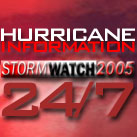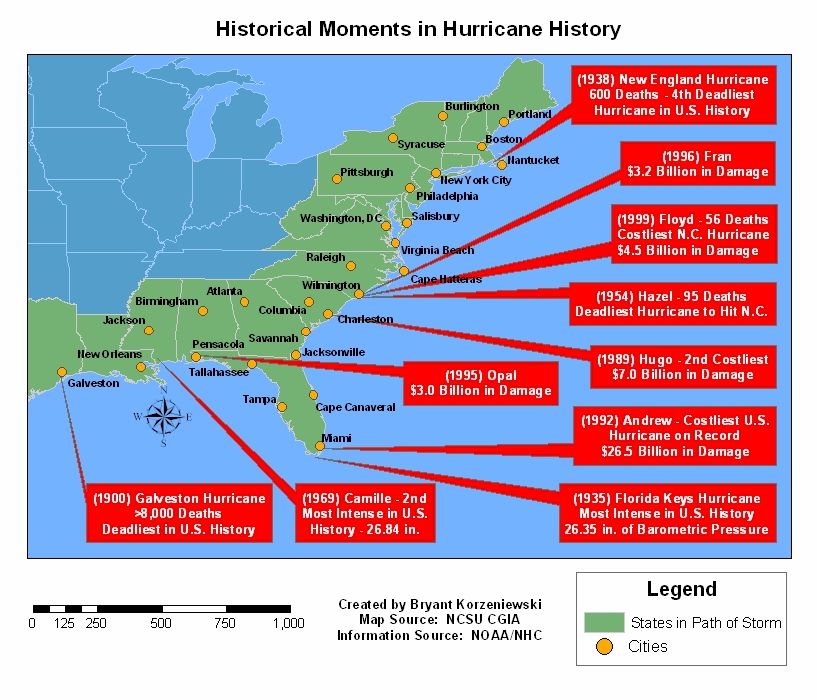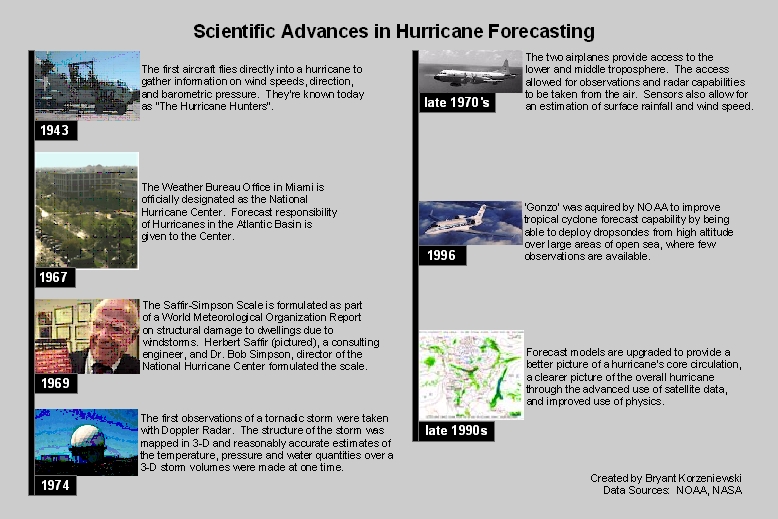Stay Up To Date Throughout the Hurricane Season with Information and Analysis in The StormWatch 2005 Storm Blog


[STORMWATCH 2005 HISTORICAL PERSPECTIVE]
It may seem like Eastern North Carolina has been the only state that has been affected by Hurricanes. However, looking back in history, there have been several hurricanes that have had a physical, monetary and intense impact on the Eastern Seaboard and Gulf Coast of the United States. The map below shows only a sampling of some of the most intense, deadliest and costliest hurricanes to ever hit the United States.
Click on the map that follows for a full view:

The map above contains information on hurricanes through the 2003 Hurricane Season.
[STORMWATCH 2005 SCIENTIFIC ADVANCES]
We can attribute the improved forecasting of tropical systems to many advances in science and technology. As recently as this year, we have seen how improved a forecast from the National Hurricane Center has warned millions of American Citizens to evacuate from a storm's determined path of influence. However, we have a long ways to go before almost 100 percent accuracy can be achieved. Thanks to the advances of the past, Americans have hope for improved forecasting and minimizing a hurricane's effects on mankind in future hurricane seasons.
Click on the map below for a timeline of the scientific advances that have been made in Hurricane Forecasting:

[FACTS AND STATISTICS ABOUT HURRICANES]
STRONGEST HURRICANE RECORDED
-
Florida Keys Storm of 1935
-
Category 5 Storm
-
500 Deaths
MOST INTENSE HURRICANES RECORDED
-
Labor Day Storm of 1935
-
Category 5 Storm
-
400 Deaths in Florida
Camille (1969)
-
25 foot Storm Surge
-
256Deaths
-
Flooding from Gulf Coast through the Mid-Atlantic States
DEADLIEST U.S. LAND FALLING HURRICANE
-
The Galveston Island Storm of 1900
-
Category 4 Storm
-
~8000 Deaths
COSTLIEST U.S. LAND FALLING HURRICANE
-
Andrew (August 1992)
-
>$25 billion in damage
OTHER STATISTICS
On average, hurricanes cause 17 deaths in the United States each year. Flooding causes 147 deaths per year.
-
STORM SURGES attribute 9 out of every 10 deaths related to hurricanes.
-
Hurricanes lose most of their energy within 12 hours of landfall.
-
Atlantic Hurricane Season: June 1st through November 30th
-
1953: The first year with Male named hurricanes in alphabetical order.
-
1956: The first year where a hurricane was given a female name.
-
On average, 100 tropical disturbances form in the Atlantic Ocean each year:
-
10 of these disturbances become named Tropical Storms.
-
6 of the Tropical Storms form to become Hurricanes.
-
2 of the Hurricanes are the most likely to strike the United States.
-
The STRONGEST HURRICANES can happen during a very inactive hurricane season:
-
ALICIA (1983): only 4 named storms
-
ANDREW (1992): only 6 named storms
-
-
Hurricanes rotate Counter-Clockwise in the Earth's Northern Hemisphere.
-
It takes more time to evacuate an area in the path of a hurricane than it did 10 years ago.
Copyright 2004-2005 BRYANT KORZENIEWSKI
DISCLAIMER: This website doesn't assume responsibility for content that appears as a result of third-party links or RSS Feeds. The content provided by third-party links or RSS Feeds is the sole responsibility of their owners and the owner is noted where possible. Original content and images designed by StormWatch2005 are copyrighted and cannot be used without prior written consent.
Page Last Updated on 09/25/2005
Add RSS Feeds via Javascript to Your Web Page!
